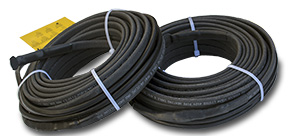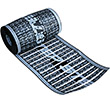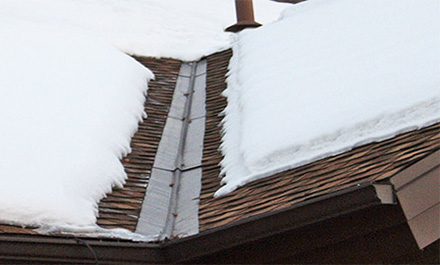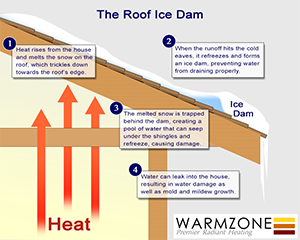Buffalo Roof Deicing Solutions
Roofs in Buffalo are used to heavy loads of snow. While many residents in New York and New England use roof rakes to limit the snow loads on their roofs, this is often unnecessary, and can result in damaging the roof shingles. Most residential roofs are designed to withstand 20 pounds per square feet of snow. That’s about four feet of fresh snow. The biggest concern is usually not the weight load, but the runoff underneath all that snow, and ice dams.
Ice dams cause more damage to roofs and homes each year than any other roof related issue. Ridges of ice develop at the roof eaves, causing runoff to pool behind the ice where it can seep into tiny cracks in shingles. As the water refreezes, the ice expands and exploits the cracks, making them larger over time. Eventually, this may lead to leaks and water damage.
 The most effective way to prevent ice dams it to provide unobstructed paths for the runoff.
This is typically done with strands of heat cable or a roof deicing system installed under the
roof shingles.
The most effective way to prevent ice dams it to provide unobstructed paths for the runoff.
This is typically done with strands of heat cable or a roof deicing system installed under the
roof shingles.
Self-regulating heat trace cable is an easy and affordable solution for preventing ice dams. Using roof clips, the cable can be clipped to shingles and run along the roof eaves in a zig zag pattern to break up any areas where ice may build up and prevent runoff. The cable can also be routed through the roof gutters and downspouts as a heat trace system to further facilitate runoff.
One of the most trusted roof deicing systems features thin, low-voltage polymer heating elements that can be installed discreetly under the shingles to provide a “clean” solution to ice dams. This advanced heating element can also be installed under metal roof valleys to provide a clear channel for melting snow. The low-voltage system is known as RoofHeat STEP, because a transformer is used to step down high voltage to low voltage (60 V or less). The flexible heating element is also self-regulating and can be nailed or stapled through during installation without causing damage. (However, do not nail or staple the bus braids along the side of the heating element.)

 Warmzone provides detailed layouts for each roof heating system, so your installer will know all
the power requirements and technical information prior to any installation taking place. We pride
ourselves on providing customers with the best service in the business. To learn more about your roof
deicing options, and information about experienced installers in your area, contact Warmzone today
at 888.488.9276.
Warmzone provides detailed layouts for each roof heating system, so your installer will know all
the power requirements and technical information prior to any installation taking place. We pride
ourselves on providing customers with the best service in the business. To learn more about your roof
deicing options, and information about experienced installers in your area, contact Warmzone today
at 888.488.9276.
Warmzone Roof Deicing Systems and Services
Warmzone understands what it takes to design and install effective roof heating systems. There are many roof heating options, and each option can be customized to provide roof deicing for just about any type of roof and configuration. We’ll work with you to provide the best solution for your specific budget and roof deicing needs. Call a roof heating expert today at 888.488.9276 to learn more about your options. We’re happy to answer any questions you may have – without any pushy sales pressure.

